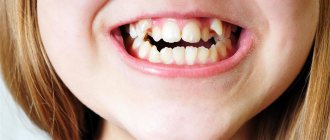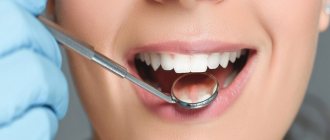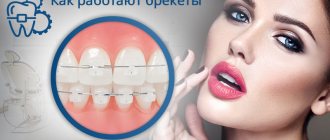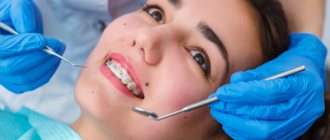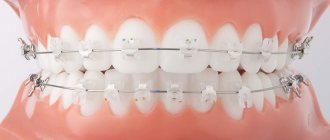Indications for treatment with Invisalign
As noted above, Invisalign aligners cope with almost any malocclusion and are in no way inferior in effectiveness to braces. Both adults and teenagers can undergo treatment with Invisalign. Today, milk and mixed dentition are no obstacle to wearing Invisalign aligners. The technology allows you to take into account both the growth of the jaws and the change of teeth. Invisalign technology does not have an upper age limit, as with treatment with braces.
List of indications
- The technology has no restrictions in the treatment of malocclusions and tooth position. Everything depends only on a correctly drawn up treatment plan by the doctor. Enlarged gaps between the side teeth or gaps and gaps between the front incisors, or diastemas - these are all the simplest problems that Invisalign technology can handle! The same applies to crowded teeth, in which they seem to “run into” each other, pushing neighbors beyond the dentition or turning around their axis in order to fit in the jaw.
- Crowding of teeth, in which they seem to “run into” each other, pushing neighbors beyond the dentition or turning around their axis in order to fit in the jaw.
- Occlusion disorders that do not require orthognathic surgery: distal, in which the lower jaw is shifted back relative to the upper; open when the closure of the front or chewing teeth is disturbed; cross, in which the jaws shift relative to the midline of the face; straight, in which the upper and lower incisors close with the cutting edges and there is no proper overlap of the lower jaw with the upper jaw; mesial, in which the lower jaw is pushed forward relative to the upper.
Unfortunately, there are still bite problems that neither braces nor aligners can solve - in such situations, orthognathic surgery is required, preparation for which can also be done with aligners. Most often this is due to a lack of or asymmetrically developed bone structure of the facial skeleton. However, all problems of bite and tooth position that are solved with braces are also corrected with the help of Invisalign technology, and much more accurately, comfortably and completely invisible to others!
Is there a need to give up your usual food?
As a rule, when installing a brace system, the doctor will actually announce “forbidden” foods, and this list looks quite depressing (cookies, chips, seeds/nuts, crackers, chewing gum, pizza, chocolate bars, etc. - everything that can stick to the structure , creating conditions for the proliferation of microbes, or damaging it). But in this case, the doctor’s recommendations should be approached in a differentiated manner: there is a clear reinsurance here, the only thing that is actually required from the patient is caution.
How is Invisalign treatment performed?
Straightening teeth and correcting bites with Invisalign has certain features and advantages. Compared to classic braces, the Invisalign mouthguard is completely invisible, does not affect diction, does not require any diet, does not complicate daily hygiene, does not injure or rub the tissues of the oral cavity. The system also does not cause such long-term painful sensations as braces, since the movement of teeth occurs in doses and in stages. Each kappa is one “step”.
Stages of teeth straightening with Invisalign
Step one.
At the initial consultation, a thorough diagnosis is carried out to make a diagnosis and plan treatment, preparatory therapy is prescribed (if required), oral sanitation and professional cleaning are carried out.
Step two.
Impressions are made of the patient’s jaws, from which the most accurate anatomical models are made. A photo protocol is being carried out. Based on the results of diagnostics and measurements in the special Clean Check program, future treatment is planned step by step and a 3D model is created. Using the program, it is possible to see the entire process of teeth movement and evaluate the future result.
Step three.
All necessary information is sent to the Align Technology laboratory, and a set of Invisalign aligners are manufactured in a certified factory located in the States.
Step four.
After receiving orthodontic aligners, the attending physician schedules an appointment at which he helps the patient put on the first pair, explains the treatment technology, issues the remaining sets of replacement aligners, gives recommendations for wearing and daily care, and sets a date for the next visit. Unlike braces, which require regular tightening on average once every three to four weeks, control visits to the orthodontist for Invisalign treatment require significantly fewer follow-up visits.
Step five.
Direct treatment with Invisalign takes about the same time as with braces: from six months to two years. You need to change your aligners about once every two weeks, and visit a doctor only once every one and a half to two months. The main rule and the key to success is to wear Invisalign aligners at least twenty hours a day, removing them only for meals and daily hygiene. The structure must be cleaned by soaking in a special solution, which is provided along with the aligners themselves, and the teeth must be brushed as usual - in the morning, in the evening before bed and after each meal.
Step six.
After completing treatment with Invisalign aligners and achieving the desired result, you will need to wear retainers for some time in order to consolidate the effect and prevent the teeth from returning to their original position.
Photos before and after Invisalign treatment
Therapeutic effect when correcting a bite - with braces or aligners
Since veneers are not involved in correcting the bite, the comparison is between braces or aligners. Advantages by position are highlighted in red. Leadership lies with the aligners.
| Therapeutic effect | ALINERS | BRACKETS | VENEERS |
| Treatment speed | 30% faster than braces | 30% slower than aligners | no healing effect |
| Therapeutic effect (bite correction) | Yes | Yes | No |
| How the effect is achieved | simultaneous rotation and displacement in the desired direction due to the tight grip of each tooth | sequential rotation, horizontal/vertical shift | stick on crooked teeth |
| Actual teeth straightening | Yes | Yes | No |
| Risk of developing caries | No | Yes | No |
| Whitening effect | only before or after treatment | only before or after treatment | immediately after installation |
| Possibility of changing the appearance of teeth | No | No | Yes |
| Rehabilitation period (after removal) | retainers are a MANDATORY PROCEDURE | retainers - wearing retaining mouth guards at night MANDATORY PROCEDURE | absent |
| Reversibility of treatment | partially reversible | partially reversible | irreversible changes |
| Possibility of remineralizing therapy, strengthening tooth enamel | Yes | No | No |
Removal, damage to teeth, enamel, oral mucosa. Aligners are the best
| Removal, damage to teeth, enamel, oral mucosa | ALINERS | BRACKETS | VENEERS |
| Wisdom teeth removal | Yes | Yes | not necessary |
| Removing part of tooth enamel | No | No | Yes |
| Separation of teeth before treatment | of necessity | of necessity | Yes |
| Risk of damaging existing teeth | No | yes (enamel) | There is |
| Possibility of injury to the oral mucosa | No | Yes | No |
Invisalign aligners and their analogues
Align Technology was the first to develop and patent this system, but nowadays teeth straightening trays are produced by many companies and are even sold in regular pharmacies. But this does not mean that they are all equally effective. We have compiled for you a comparison table of the main aligner manufacturers so that you have a correct idea of the benefits of each system.
| Manufacturer's brand | About company | Preparation method | Treatment effectiveness | Price |
Invisalign | Align Technology is the world's first technology developer and manufacturer of aligners. The company has a scientific and clinical base and a research laboratory. | Factory manufactured using patented SmartTrack material for a more comfortable and effective treatment experience. All products undergo strict quality control. | The only manufacturer on the market that provides evidence of the effectiveness of aligners in the form of case histories and completed treatment cases. | from 169,000 rub. |
OrthoSnap | The company appeared about 10 years ago in the United States as a manufacturer of a cheaper analogue of Invisalign aligners. | It produces mouthguards in its own research laboratory from hypoallergenic polycarbonates. The company does not use 3D models. | The product is positioned as a product capable of correcting any malocclusion. | from 100,000 rub. |
Star Smile | Russian manufacturer of aligners. The company does not have its own developments and research; it uses technologies borrowed from leading manufacturers | Star Smile mouthguards are made in the laboratory from conventional polymer materials supplied from Germany. | Openly declares the presence of limitations in treatment - the company’s website lists specific cases that can be corrected with these mouthguards. | from 80,000 rub. |
Air Align | An ambitious company that has offices in many European countries. It has its own scientific and clinical base. | Aligners are made from standard hypoallergenic plastic. | The company does not indicate which malocclusions are eligible for treatment using the Air Align system, stating that these aligners can completely replace braces. | from 150,000 rub. |
3D Smile | Has been on the market for less than 6 years. Has its own laboratory in Moscow. It does not have its own technologies or research. | For the manufacture of mouth guards, transparent polymer materials are used. | The manufacturer claims that the product is able to correct any type of malocclusion and all dental anomalies better than braces. | from 120,000 rub. |
Make an appointment
right now!
Vilnevchits Nadezhda Vladimirovna
Orthodontist
Braces and Invisalign - which is better?
Braces and Invisalign work equally well. It is a mistake to believe that mouthguards will be less effective than traditional braces. If you decide to see an orthodontist and can't decide between Invisalign and braces, schedule a consultation with several specialists. However, it must be taken into account that every doctor prefers to work with the system that is familiar to him. For this reason, even a competent orthodontist who does not work with aligners, but successfully treats with classic braces, may decide that orthodontic aligners are not suitable for you.
Is it possible to avoid painful sensations?
All owners of braces experience some discomfort when correcting dentoalveolar anomalies. Soreness occurs after the first load received. Troubles are also caused by microtrauma caused by protruding elements of braces. Later, patients get used to the constant but moderate traction force of the orthodontic arch.
Removable aligners can also cause a lot of problems. If you take them off for half an hour to eat, the teeth, which have received serious chewing load during this time, will have time to shift, and in the direction opposite to that specified by the program. Therefore, after putting on the device, painful sensations will occur. And since the treatment will continue for at least 8-12 months, you will have to remove and put on the aligners up to 5 times a day, and the pain will be felt again several thousand times. Not everyone can endure such a test.
What to choose - Star Smile or Invisalign?
Demand creates supply, and competition is the engine of progress. In this regard, in recent decades, more and more new analogues of the first elastic mouth guards for correcting malocclusion have entered the market. So, in addition to the proven Invisalign aligners, you can find many other brands, both foreign and domestic. Some of them honestly, like the Star Smile company, admit that the number of cases that can be treated on their system is limited. Some, like OrthoSnap, claim that their products are in no way inferior to Invisalign, but they do not use 3D modeling in the production of their aligners, which casts doubt on such slogans. Also gaining popularity among manufacturers of orthodontic aligners are Air Align, whose price tag is approaching that of Invisalign, and 3D Smile.
However, only Invisalign's patented aligners are manufactured in a specialized factory from SmartTrack, a hypoallergenic, elastic material that provides maximum comfort and treatment effectiveness. And only Align Technology has been investing in fundamental developments for decades, maintaining a scientific and clinical base of strict reporting and maintaining a research laboratory. The Invisalign company has consultants (orthodontic professors) on its staff and was among the first to pay close attention to functional diseases of the temporomandibular joint - the so-called TMJ dysfunctions.
The only advantage of all of the above competitors is their comparatively lower price, but only Invisalign has such a long experience and proven results in the treatment of many thousands of patients.
Features of the action of orthodontic structures
The topic of aligners or braces - which is better - is discussed on forums. Patients talk about their impressions, and doctors explain how both designs work. In braces, a metal arch with a memory effect gradually returns the teeth to a physiologically justified position, restrains jaw growth or, conversely, stimulates it. Visits to the orthodontist are needed to change the tension of the arch.
The good thing about aligners is that they can be used by children as young as 6 years old.
, whose permanent teeth have not yet grown. Correcting a child’s bite with aligners can only be entrusted to a highly qualified orthodontist dentist with extensive clinical experience. An accurate prognosis is important - templates are made for the entire course at once; at the very beginning of treatment, the doctor writes out the algorithm using a specialized computer program.
Stars who wore aligners
Most celebrities cannot afford to wear braces, so Invisalign aligners have become a real salvation for them.
Gisele Bündchen
The only flaw in Giselle's appearance was once a crooked front tooth, for the sake of straightening which she put on aligners.
Zac Efron
Many celebrities are proud of their gap hair, but not Zac Efron. The gaps between his front teeth gave him a rustic appearance. Thanks to wearing aligners, the actor’s appearance changed dramatically.
Khloe Kardashian
Socialite Chloe always thought she had uneven teeth and wanted to fix them, but only decided to undergo orthodontic treatment last year.
Justin Bieber
A favorite of teenage girls, sweet-voiced Justin would never agree to ruin his image and put braces on his teeth. The Invisalign system helped him achieve his perfect smile.
Eva Longoria
Desperate housewife Eva Longoria is rarely tormented by doubts. I decided to correct my crooked teeth - I chose Invisalign - and that was the end of it!
